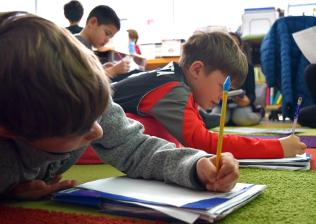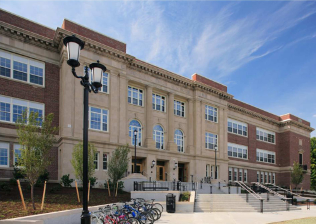Green Schoolhouses
Because school age children spend more time in schools than any other building aside from their homes, the schools they attend should be safe, clean, comfortable, and well equipped.
Green schools all share a commitment to environmental sustainability. They improve students' learning, safeguard children's health, and save money.

Green Ribbon Schools
We are excited to announce that the 2026 Rhode Island Green Ribbon Schools Award (RI-GRSA) application is now open! Building off of the US-ED Green Ribbon Schools Award, this prestigious program recognizes schools that excel in reducing environmental impact and costs, improving the health and wellness of students and staff, and providing effective sustainability education. By applying, your school joins a statewide effort to create safe, healthy, and climate-friendly learning environments while advancing environmental stewardship. Applications, including a summary narrative and supporting visuals, are due by March 15, 2026. For questions or submission, please contact
Sara Tucker at sara.tucker@ride.ri.gov.
Let’s celebrate your leadership in building a greener, healthier future for Rhode Island students!
- 2025-2026 Green Ribbon Schools Application and Guidance [PPT, 740KB]
- 2021 US Department of Education's Director Award recognizing the outstanding service of the School Building Authority.
- 2024 Green Ribbon Schools flyer
2025 GREEN RIBBON SCHOOLS WINNERS:
Coming soon...
2024 U.S. DEPARTMENT OF EDUCATION GREEN RIBBON SCHOOLS WINNERS:
- Dunn's Corners School
- D'Abate Elementary School
- Spaziano Elementary School
- Garden City Elementary School
- Chariho Regional School District
2023 U.S. DEPARTMENT OF EDUCATION GREEN RIBBON SCHOOLS WINNERS:
2022 U.S. DEPARTMENT OF EDUCATION GREEN RIBBON SCHOOLS WINNERS:
2021 U.S. DEPARTMENT OF EDUCATION GREEN RIBBON SCHOOLS WINNERS:
2019 U.S. DEPARTMENT OF EDUCATION GREEN RIBBON SCHOOLS WINNERS:
2018 U.S. DEPARTMENT OF EDUCATION GREEN RIBBON SCHOOLS WINNERS:
2017 U.S. DEPARTMENT OF EDUCATION GREEN RIBBON SCHOOLS WINNERS:
2015 U.S. DEPARTMENT OF EDUCATION GREEN RIBBON SCHOOLS WINNERS:
2014 U.S. DEPARTMENT OF EDUCATION GREEN RIBBON SCHOOLS WINNERS:
2013 U.S. DEPARTMENT OF EDUCATION GREEN RIBBON SCHOOLS WINNERS:
2012 U.S. DEPARTMENT OF EDUCATION GREEN RIBBON SCHOOLS WINNERS:
Sustainable High Performing Schools
Facilities matter. And sustainable schools, or green schools, are the highest quality learning environments. They provide plenty of light and excellent air circulation and climate control. Green schools save taxpayer dollars - through economies during construction and through long-term savings on energy and utility costs. Green schools can also provide excellent opportunities for student explorations in science, ecology, engineering, and other career & technical fields.
Energy Efficiency and Zero Energy
Since their adoption in 2007, the School Construction Regulations (SCR) have established standards that ensure statewide uniformity and equity in the quality of school construction. The School Construction Program has worked diligently over the course of the last five years to ensure that the equity and uniformity described in the regulations extend to each project’s finances. The School Construction staff works with districts to ensure responsible, efficient, and forward-looking use of state and local resources.

Furthermore, as of 2007, RIDE ensures that all projects comply with the requirements set forth in the most recent Northeast Collaborative for High Performance Schools Protocol (NECHPS) so that approved projects provide high quality learning environments, conserve natural resources, consume less energy, are easier to maintain, and provide an enhanced school facility.
With the leadership and oversight of the School Construction Program, Rhode Island public schools that have undertaken construction projects use at least 30% less energy and 20% less water than buildings designed to code, and have diverted at least 50% of construction waste from the landfill. And many projects are striving to go far beyond these standards to create sustainable, efficient, and high performance 21st century learning environments.
Energy Efficiency In Our Schools Document
NECHPS VERIFIED
- Providence Career Technical Academy
- Nathan Bishop Middle School
- East Greenwich - Cole Middle School
- Little Compton – Wilbur McMahon Renovation
- Newport – Pell Elementary School
- Paul Crowley East Bay MET School
